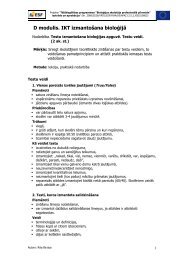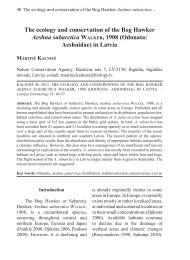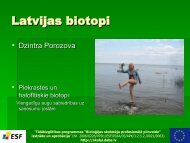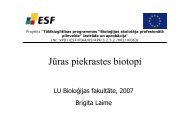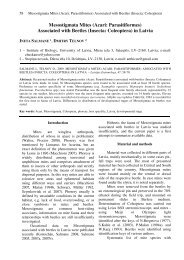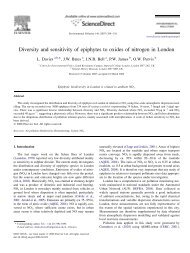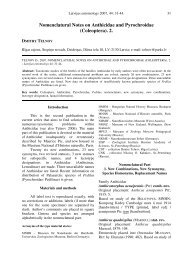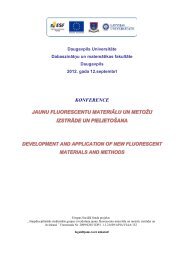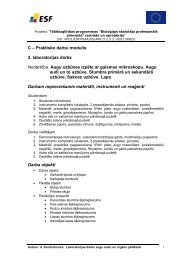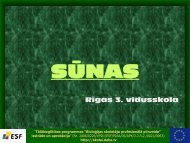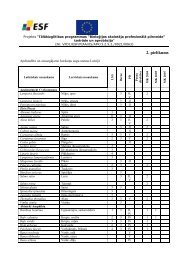Odonata - Entomological Society of Latvia - Latvijas Daba
Odonata - Entomological Society of Latvia - Latvijas Daba
Odonata - Entomological Society of Latvia - Latvijas Daba
You also want an ePaper? Increase the reach of your titles
YUMPU automatically turns print PDFs into web optimized ePapers that Google loves.
The Calluna vulgaris and Andromeda polifolia vegetation structure had the largest mean<br />
percent cover in transects, i.e. on average 24.8% <strong>of</strong> the area <strong>of</strong> sampling plots and open water area,<br />
i.e. on average, 21.7% <strong>of</strong> the area <strong>of</strong> sampling plot, respectively (Figure 6).<br />
%<br />
30,0<br />
25,0<br />
20,0<br />
15,0<br />
10,0<br />
5,0<br />
0,0<br />
Water<br />
Lielais Ķemeru Bog<br />
Sudas-Zviedru Bog<br />
Water with Sphagnum mosses<br />
Wet sunken Sphagnum<br />
mosses<br />
Sphagnum mosses with Carex<br />
limosa<br />
Hummocks <strong>of</strong> Sphagnum<br />
mosses<br />
Sphagnum mosses with<br />
Eriophorum spp.<br />
water and vegetation structures<br />
Sphagnum mosses with<br />
Rhynchospora alba,<br />
Scheuchzeria palustris<br />
Ledum palustre and Vaccinium<br />
uliginosum<br />
Calluna vulgaris and<br />
Andromeda polyfolia<br />
High Carex spp.<br />
Figure 6. Mean percent cover <strong>of</strong> water and vegetation structures in sampling plots in Sudas-Zviedru<br />
Bog (16 sampling plots) and Lielais Ķemeru Bog (16 sampling plots) in 2007.<br />
The DCA analysis identified a gradient <strong>of</strong> dragonfly species that were related to cover <strong>of</strong><br />
immerged Sphagnum mosses, Calluna vulgaris with Andromeda polifolia as well as the open water<br />
(Figure 7). DCA Axis 1 separated dragonfly communities on their vertical distribution in relation to<br />
vegetation structure. On the right side <strong>of</strong> the ordination are species such as Leucorrhinia dubia,<br />
which fly low ower macrophytes, such as Erythromma najas, which fly very close to the surface <strong>of</strong><br />
water. In the middle <strong>of</strong> the ordination dragonfly species such as Lestes sponsa, Leucorrhinia<br />
albifrons, whose individuals are usually seen on caulescent plants <strong>of</strong> different heights and small<br />
shrubs at shores <strong>of</strong> bog water bodies. On the left side <strong>of</strong> the ordination are species such as Anax<br />
imperator and Aeshna juncea, which fly high over water or vegetation. DCA Axis 2 is related to a<br />
moisture gradient from open water and water with Sphagnum moss at the bottom and relatively dry<br />
microhabitats (Calluna vulgaris and Andromeda polifolia) at the top. Aeshna juncea, Aeshna<br />
grandis and Anax imperator which patrol above water are located at the bottom <strong>of</strong> the ordination.<br />
Also Lestes sponsa, Enallagma cyathigerum and Leucorrhinia albifrons appear to be related to the<br />
vegetation close to water, Leucorrhinia dubia was associated with dry sites comparatively far away<br />
from water bodies.<br />
There was a significant correlation <strong>of</strong> sites between the number <strong>of</strong> dragonfly species in<br />
sampling plots and the cover <strong>of</strong> open surface (r=0.450, p≤0.05, n=30) as well as between the<br />
number <strong>of</strong> dragonfly species and water with Sphagnum mosses (r=0.376, p≤0.05, n=30). There was<br />
also a close positive correlation between open water cover and E. cyathigerum (r=0.645, p≤0.01,<br />
n=30) and also L. albifrons (r=0.578, p≤0.01, n=30). There was also a close positive correlation<br />
between E. cyathigerum and the Ledum palustre and Vaccinium uliginosum vegetation type (r=560,<br />
p≤0.01, n=30).<br />
58



